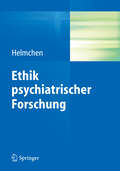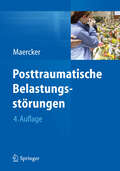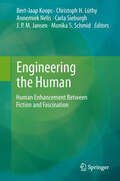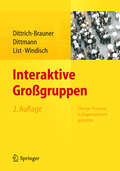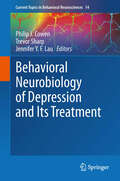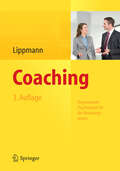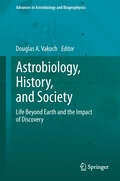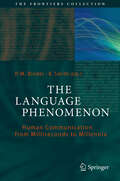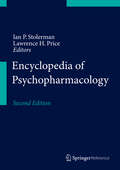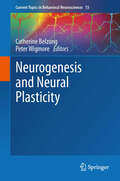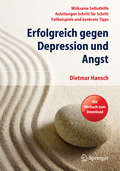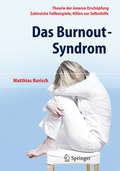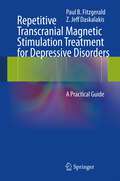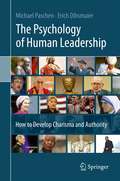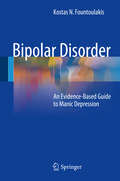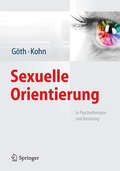- Table View
- List View
Praxis der Schlafmedizin: Schlafstörungen bei Erwachsenen und Kindern Diagnostik, Differenzialdiagnostik und Therapie
by Joachim T. Maurer Leonie Fricke-Oerkermann Boris A. Stuck Michael Schredl Hans-Günter WeeßSchlafstörungen - eine der häufigsten Erkrankungen Über eine halbe Million Menschen nehmen in Deutschland regelmäßig Schlafmittel ein. Eine notwendige differenzierte schlafmedizinische Diagnostik - die Voraussetzung für eine optimale langfristige Therapie - erfolgt häufig nicht. Beschwerden durch nicht erholsamen Schlaf können Leistung und Lebensqualität der Betroffenen massiv beeinträchtigen, oft mit langfristigen Auswirkungen auf die Gesundheit. Das Lehr- und Lernbuch zur Prüfungsvorbereitung Qualifikationsnachweis Somnologie der DGSMZusatzbezeichnung Schlafmedizin"BUB"-KurseDer Ratgeber für die tägliche, praktische Tätigkeit in Klinik und Praxis Grundlagen, MethodenDiagnostik, DifferentialdiagnostikTherapien Alles, was wichtig, häufig und klinisch relevant ist mit · Praxistipps, Fallbeispielen · Fragen zur Prüfungsvorbereitung NEU berücksichtigt: u.a. Neueste Richtlinien zu Indikation und Auswertung der Polysomnographie Begutachtung der Tagesschläfrigkeit im Rahmen der FahrtauglichkeitsdiagnostikBehandlungsansätze zu Insomnien Bewegungsstörungen im Schlaf Nach neuesten Klassifizierungen ICSD-2Scoring Manual der AASM Gültig für den gesamten deutschsprachigen Raum (Deutschland, Österreich, Schweiz). Nach den Empfehlungen der Deutschen Gesellschaft für Schlafforschung und SchlafmedizinEuropean Sleep Research SocietyAmerican Academy of Sleep Medicine
Ethik psychiatrischer Forschung
by Hanfried HelmchenErstmals für den deutschen Sprachraum werden hier die ethischen Implikationen der Forschung mit psychisch Kranken umfassend dargestellt. Diese Forschung zielt darauf, den faktisch, ethisch und rechtlich begründeten Bedarf an evidenzbasiertem Wissen zur Diagnostik und Behandlung psychisch Kranker zu decken. Forschung wird dabei als Intervention verstanden, die mit Patienten mittels wissenschaftlichen Methoden auf überindividuelles Wissen zielt und damit über den individuellen Nutzen für den teilnehmenden Patienten hinausgeht. Solche Forschungsintervention ist ethisch nur vertretbar, wenn erstens ihr Nutzen-Risiko-Verhältnis vernünftig und gerechtfertigt und zweitens die Einwilligung nach Aufklärung gültig ist. Dass diese Grundvoraussetzungen für jedes konkrete Forschungsprojekt eingehalten werden, wird gesellschaftlich über Ethikkommissionen kontrolliert. Denn Vertrauen der Öffentlichkeit in die ethische Vertretbarkeit der klinischen Forschung ist eine wesentliche Voraussetzung für die Bereitschaft von Menschen, an solcher Forschung teilzunehmen. Diese theoretischen Ausführungen werden im zweiten Teil des Buches durch konkrete Beispiele aus ausgewählten Forschungsgebieten veranschaulicht."
Posttraumatische Belastungsstörungen
by Andreas MaerckerGewalterfahrungen, Unfälle, Katastrophen oder Todesfälle im nahen Umfeld, extreme Situationen können zu einer posttraumatischen Belastungsstörung führen. Darunter werden unterschiedliche psychische und psychosomatische Symptome zusammengefasst, die als Langzeitfolgen auch noch Jahre nach dem belastenden Erlebnis auftauchen können. Heute gibt es eine Vielzahl von Interventionen, eine PTSD wirksam zu behandeln oder ihr durch frühzeitige Therapie entgegen zu wirken. Die Neuauflage des 1997 in erster Auflage erschienen Werks wurde umfassend überarbeitet und erweitert: Neu konzipiert oder wesentlich revidiert in der 4. Auflage sind unter anderem Kapitel zu: - Systematik, Klassifikation und Epidemiologie - Neurobiologie - Begutachtung - Notfallpsychologie - Kognitive Verarbeitungstherapie - Therapie erwachsener Opfer sexuellen Kindesmissbrauchs DAS Handbuch zu posttraumatischen Belastungsstörungen
Engineering the Human
by Monika S. Schmid Carla Sieburgh Bert Jaap Koops J.P.M. Jansen Annemiek Nelis Christoph H. LüthyThe volume is collection of articles treating the topic of human improvement/enhancement from a variety of perspectives - philosophical, literary, medical, genetic, sociological, legal etc. The chapters in this volume treat not only those aspects that most immediately come to mind when one thinks of 'human enhancement', such as genetic engineering, cloning, artificial implants and artificial intelligence etc. Somewhat less obvious aspects include evolutionary perspectives in connection with the prolongation of the human lifespan, plastic surgery since its beginnings, and questions such as whether the distinction between 'natural' and 'artificial' can really be drawn at all and how it has been conceived across the ages, or what the legal implications are of recent developments and techniques. Many papers make links to the representation of these developments in popular culture, from Jules Verne through Aldous Huxley to the movie Gattaca, address the hopes and fears that come with them as well as the question how realistic these are. While all chapters are written by scientists at the international top of their respective fields, all are accessible to a non-specialist audience and eminently readable. We believe that they represent a state-of-the art overview of questions that are of interest to a large audience. The book thus targets a non-specialist audience with an interest in philosophical, sociological, scientific and legal issues involved in both traditional and recent matters concerning the desire of mankind to improve itself, the human body, the human mind and the human condition. It is unique in that it brings together all these aspects within a coherent and cohesive collection.
Attracted to Conflict: Dynamic Foundations Of Destructive Social Relations (Peace Psychology Book Series)
by Peter T. Coleman Andrzej Nowak Larry Liebovitch Andrea Bartoli Katharina Kugler Robin R. Vallacher Lan Bui-WrzosinskaConflict is inherent in virtually every aspect of human relations, from sport to parliamentary democracy, from fashion in the arts to paradigmatic challenges in the sciences, and from economic activity to intimate relationships. Yet, it can become among the most serious social problems humans face when it loses its constructive features and becomes protracted over time with no obvious means of resolution. This book addresses the subject of intractable social conflict from a new vantage point. Here, these types of conflict represent self-organizing phenomena, emerging quite naturally from the ongoing dynamics in human interaction at any scale--from the interpersonal to the international. Using the universal language and computational framework of nonlinear dynamical systems theory in combination with recent insights from social psychology, intractable conflict is understood as a system locked in special attractor states that constrain the thoughts and actions of the parties to the conflict. The emergence and maintenance of attractors for conflict can be described by means of formal models that incorporate the results of computer simulations, experiments, field research, and archival analyses. Multi-disciplinary research reflecting these approaches provides encouraging support for the dynamical systems perspective. Importantly, this text presents new views on conflict resolution. In contrast to traditional approaches that tend to focus on basic, short-lived cause-effect relations, the dynamical perspective emphasizes the temporal patterns and potential for emergence in destructive relations. Attractor deconstruction entails restoring complexity to a conflict scenario by isolating elements or changing the feedback loops among them. The creation of a latent attractor trades on the tendency toward multi-stability in dynamical systems and entails the consolidation of incongruent (positive) elements into a coherent structure. In the bifurcation scenario, factors are identified that can change the number and types of attractors in a conflict scenario. The implementation of these strategies may hold the key to unlocking intractable conflict, creating the potential for constructive social relations.
Interaktive Großgruppen: Change-Prozesse in Organisationen gestalten
by Carmen Windisch Volker List Karin Dittrich-Brauner Eberhard DittmannOrganisationen und ihre Mitarbeiter verändern sich fortlaufend und lernen dazu, um konkurrenzfähig zu bleiben. Zu diesem Zweck setzen Unternehmen immer häufiger Großgruppenverfahren ein, denn diese haben klassischen Workshopmethoden einiges voraus: Sie erzeugen Bewegung, initiieren Kontakte und Diskussionen, fördern die Identifikation und garantieren die Nachhaltigkeit von Veränderungen in Organisationen - kurz: sie binden auf aktive und effektive Weise viele Menschen in einen gemeinsamen Entwicklungsprozess ein. Die Arbeit mit großen Gruppen ist gleichzeitig zielführend und unterhaltsam. Alles drin: Zum einen "klassische Verfahren" wie Zukunftskonferenz, Open Space, Appreciative Inquiry, RTSC, World Café, sowie deren Entwicklung, Einsatzgebiete, Ablauf und Nutzen. Zum anderen Weiterentwicklungen und Trends, neue Anforderungen, integrative Ansätze, Einbindung neuer Technologien u.v.m., sowie Tipps zur Dramaturgie in Großgruppen. Direkt loslegen: Mit konkreten Tipps, Checklisten, Experteninterviews, Fallbeispielen und Erfahrungsberichten aus bekannten Unternehmen, Hinweisen zu speziellen Einsatzmöglichkeiten von Großgruppenverfahren und, damit nichts schiefgeht, Vorbereitungs-Tipps zu Räumlichkeiten, Ton, Visualisierung, Dokumentation und Zeitplanung. Die zweite Auflage wurde aktualisiert und um aktuelle Themen (u.a. Social Media, Großgruppen in Veränderungsprojekten) ergänzt.
Natürlich mehr leisten!: Von Sportlern lernen - als Führungskraft erfolgreich sein, gesund bleiben
by Jana Leidenfrost Andreas SachsErfolgreiche Menschen rufen jederzeit, punktgenau und in vielfältigen Situationen ihre beste Leistung ab. Doch um die Leistungsfähigkeit auch langfristig zu bewahren und dabei gesund zu bleiben, bedarf es einer guten Balance aus Leistung und Regeneration. In der westlichen, stark aufgabenorientierten Wirtschaftswelt ist diese Erkenntnis bisher wenig umgesetzt - entsprechend nehmen Burnout u.a. psychische Krisen stetig zu. Im Spitzensport ist sie dagegen seit langem ein Erfolgsfaktor: Denn es gehört zu unseren ganz menschlichen Potenzialen, auf natürliche Weise "mehr" zu leisten und dabei auf allen Ebenen fit zu bleiben - vorausgesetzt, der "Trainingsplan" stimmt! Die Autoren dieses Buches wissen das aus eigener Erfahrung, denn sie sind sowohl als Leistungssportler als auch Unternehmensberater erfolgreich. Hier geben sie neue Impulse für eine erfolgreiche Führungsarbeit und ein positives Leistungsverständnis, indem sie Erfolgsfaktoren, Trainingsmethoden und positive Bilder aus dem Sport auf den Wirtschaftsbereich übertragen. - Dabei entsteht eine neue Sicht auf Themen wie Motivation, innerer Antrieb, Vision und Zielbildung, Flow oder Teamgeist. Im Detail vermittelt dieses Buch Haltungen, Techniken und Trainingspläne für das Management der eigenen Energie sowie der Team- und Organisationsperformance. Letztlich liefert es damit einen Beitrag zur aktuellen Burnout-Diskussion und eröffnet neue Möglichkeiten der Potenzialentfaltung. Ein Buch für alle, die auf gesunde Weise Leistung bringen, Mitarbeiter entsprechend fördern und ihre Organisationen nachhaltig gestalten möchten.
Wenn Zwänge das Leben einengen
by Nicolas Hoffmann Birgit HofmannDer Klassiker für Betroffene - erweitert und mit neuen Übungen: Zwangsgedanken und Zwangshandlungen können das Leben völlig lähmen oder ersticken. Von Angst- oder Ekelgefühlen getrieben, sieht sich der Betroffene gezwungen, die schrecklichsten Gedanken zu denken oder die unsinnigsten Handlungen auszuführen. So kommt es zu endlosen oder zeitraubenden Kontrollen, etwa ob die elektrischen Geräte ausgeschaltet sind. Oder der Betroffene verbringt sehr viel Zeit damit, seine Hände von vermeintlich gefährlichen Bakterien zu befreien. Geschrieben für Zwangskranke und ihre Angehörigen, für Therapeuten und Berater, die dieses Buch ihren Klienten empfehlen können, sowie für alle Interessierte.
Analytische Psychotherapie zwischen 18 und 25: Besonderheiten in der Behandlung von Spätadoleszenten (Psychotherapie: Praxis)
by Holger SalgePsychotherapie mit Patienten im Übergang zum Erwachsenwerden Die Spätadoleszenz ist eine Zeit des Abschieds. Eines Abschieds von den Eltern, von einem gesellschaftlichen Schutzraum (der bis dato Handeln ohne allzu weitreichende Konsequenzen ermöglichte) und von kompensierenden Omnipotenz- und Grandiositätsvorstellungen. Durch den Verlust äußerlich strukturierender Gegebenheiten kommt in dieser Lebensphase die "innere Ausstattung" auf den Prüfstand. In der Versorgungspraxis besteht eine Besonderheit bei der Psychotherapie junger Erwachsener: Je nach Alter beim Behandlungsbeginn werden die jungen Patientinnen und Patienten von Kinder- und Jugendlichenpsychotherapeuten oder von Erwachsenentherapeuten behandelt. Die Praxis zeigt oft: Beide Therapeutengruppen sind unzureichend auf diese Patientengruppe vorbereitet. Praxisorientiert: Nutzen und Fallstricke in der Therapie Der therapeutische Umgang mit Patientinnen und Patienten in dieser Lebensphase (18-25 Jahre) stellt besondere Anforderungen an die Therapeutin, den Therapeuten und spielt sich ab im Spannungsfeld von - diagnostischer Unsicherheit und heftigen Gegenübertragungsreaktionen auf Seiten der Therapeutinnen und Therapeuten bzw. des therapeutischen Teams sowie - Sprachlosigkeit, Ambivalenz gegenüber dem therapeutischen Angebot, massiver Scham und (unbewusster) Angst vor der eigenen Destruktivität auf Seiten des jungen Patienten. Dieses Buch bietet eine praxisorientierte Einführung in die Besonderheiten der Psychotherapie mit Spätadoleszenten und jungen Erwachsenen. Geschrieben für analytische und tiefenpsychologische Psychotherapeuten in Ausbildung und Praxis, aber auch Praktiker anderer theoretischer Orientierung, die sich mit der Therapie und Beratung von Patienten zwischen 18 und 25 vertraut machen möchten
Behavioral Neurobiology of Depression and Its Treatment (Current Topics in Behavioral Neurosciences #14)
by Trevor Sharp Jennifer Y Lau Philip J. CowenThe book highlights important new research using current state-of-the-art approaches by prominent researchers in the field of depression. A broad range of topics is covered, beginning with a description of the phenotypic features of clinical depression, followed by chapters on the cellular and molecular basis, functional neuroimaging correlates and information-processing accounts. Finally, existing and novel treatment approaches are covered. In this way the volume brings together the key disciplines involved in the neurobiological understanding of depression to provide an update of the field and outlook to the future. Together, the volume chapters provide focused and critical reviews that span a broad range of topics suitable for both students and established investigators interested in the present state of depression research.
Konfliktmanagement im Unternehmen
by Stephan ProkschIn dem Band wird anhand zahlreicher Praxisbeispiele dargestellt, wie Konflikte in Unternehmen traditionell gehandhabt werden und welche neuen Formen der Konfliktbearbeitung es gibt. Innovative Methoden und ihre Einsatzmöglichkeiten werden nachvollziehbar dargestellt, wobei sich der Autor auf die Mediation als wirkungsvolle Form der Konfliktlösung konzentriert. Frage- und Gesprächstechniken der Mediation werden leicht verständlich erklärt, die Einführung von Mediation in Organisationen wird anhand von Fallstudien und eines Vorgehensmodells erläutert.
Coaching: Angewandte Psychologie für die Beratungspraxis
by Eric LippmannCoaching ist in aller Munde, die Angebote sind zahlreich, der Markt ist mittlerweile von vermeintlich neuen "Tools", Techniken und Ansätzen etc. fast übersättigt und sehr unübersichtlich. Diese Buch hilft, den Überblick zu behalten. Es stellt wirklich relevante Coaching-Ansätze nach einheitlichem Raster vor: Das Wichtigste in Kürze, typische Fragestellungen, Fallbeispiele, Erfolgskriterien für Berater, Besonderheiten einzelner Zielgruppen. Es informiert über wichtige Settings im Coaching-Prozess: Einzeln, in der Gruppe, kollegial, extern oder intern, als Selbst- oder Online-Coaching. Es hilft bei der Abstimmung auf bestimmte Zielgruppen: Coaching für Führungskräfte auf allen Managementebenen, im Familienunternehmen, für Schulleiter oder Lehrer, im Personalmanagement oder in der Politik. Es gibt Tipps für unterschiedliche Anwendungsfelder: Coaching bei Veränderungsprozessen, bei Konflikten, im Rahmen der betrieblichen Bildung, im Umgang mit Medien, bei Laufbahnfragen, bei Freistellungen. Kurz: Es ist ein Standardwerk für Praktiker, geschrieben von Top-Fachleuten der Branche - nun in überarbeiteter dritter Auflage und mit neuen Kapiteln zu psychodynamischen Ansätzen, Diversity-Aspekten oder Coaching im Sport. Mit Serviceteil für Coaches und Coachees: Suche und Auswahl von Coaches, Links für Coaches zu Aus- und Weiterbildungen, Kongressen, Zeitschriften, kommentierte Literaturtipps.
Astrobiology, History, and Society: Life Beyond Earth and the Impact of Discovery (Advances in Astrobiology and Biogeophysics)
by Douglas A. VakochThis book addresses important current and historical topics in astrobiology and the search for life beyond Earth, including the search for extraterrestrial intelligence (SETI). The first section covers the plurality of worlds debate from antiquity through the nineteenth century, while section two covers the extraterrestrial life debate from the twentieth century to the present. The final section examines the societal impact of discovering life beyond Earth, including both cultural and religious dimensions. Throughout the book, authors draw links between their own chapters and those of other contributors, emphasizing the interconnections between the various strands of the history and societal impact of the search for extraterrestrial life. The chapters are all written by internationally recognized experts and are carefully edited by Douglas Vakoch, professor of clinical psychology at the California Institute of Integral Studies and Director of Interstellar Message Composition at the SETI Institute. This interdisciplinary book will benefit everybody trying to understand the meaning of astrobiology and SETI for our human society.
The Language Phenomenon
by K. Smith P. M. BinderThis volume contains a contemporary, integrated description of the processes of language. These range from fast scales (fractions of a second) to slow ones (over a million years). The contributors, all experts in their fields, address language in the brain, production of sentences and dialogues, language learning, transmission and evolutionary processes that happen over centuries or millenia, the relation between language and genes, the origins of language, self-organization, and language competition and death. The book as a whole will help to show how processes at different scales affect each other, thus presenting language as a dynamic, complex and profoundly human phenomenon.
Encyclopedia of Psychopharmacology
by Ian P. Stolerman Lawrence H. PricePsychopharmacology is the study of the effects of psychoactive drugs on the functioning of the central nervous system at all levels of analysis, thus embracing cognition, behavior, psychological states, neurophysiology, neurochemistry, gene expression, and molecular biology. It includes, as an integral part of its domain, the interaction of environmental and genetic factors with psychoactive drug action, the medicinal and social uses of drugs, and the misuse and abuse of psychoactive substances. The aim of this comprehensive encyclopedia is to provide detailed information on psychopharmacology and its sub-disciplines, such as clinical psychopharmacology, molecular neuropsychopharmacology, behavioral pharmacology in laboratory animals, preclinical psychopharmacology, and human experimental psychopharmacology. The wide-ranging entries in the Encyclopedia of Psychopharmacology are written by leading experts drawn from a broad diversity of backgrounds and areas of specialization. The entries, comprehensive but succinct, provide basic and clinical scientists in academia, as well as industry, with the most important and relevant information on recent developments in psychopharmacology and its closely allied disciplines. The essential information about the field contained in these entries is readily accessible to clinicians, scholars, students, teachers, and interested laypeople.
Neurogenesis and Neural Plasticity
by Catherine Belzung Peter WigmoreThis volume brings together authors working on a wide range of topics to provide an up to date account of the underlying mechanisms and functions of neurogenesis and synaptogenesis in the adult brain. With an increasing understanding of the role of neurogenesis and synaptogenesis it is possible to envisage improvements or novel treatments for a number of diseases and the possibility of harnessing these phenomena to reduce the impact of ageing and to provide mechanisms to repair the brain.
Erfolgreich gegen Depression und Angst
by Dietmar HanschFühlen Sie sich niedergeschlagen und energielos? Sind Sie ständig überlastet und unzufrieden? Leiden Sie unter Ängsten und körperlichen Reaktionen wie Schwindel, Herzrasen oder -schmerzen? Der Ratgeber hilft Ihnen bei der Entscheidung, ob eine Erkrankung vorliegt, Selbsthilfe möglich oder ein Arztbesuch nötig ist. Hilfe zur Selbsthilfe bei Depression und Angst: Ursachen und Eskalationsmechanismen bei Depression, Burnout, Angst- und Panikstörung werden erklärt Schritt für Schritt die Eskalation unterbrechen, Energie gewinnen, die Ausgangsprobleme lösen Ausführliche und umsetzbare Aufgabenstellungen, die Ihnen helfen, Ihre gesamte Lebenssituation zu optimieren Im Rahmen einer ganzheitlichen Lebenskunst das Gesunde fördern und die Stärken stärken Geeignet auch als Begleitmaterial für Psychotherapie (insbesondere kognitive und achtsamkeitsbasierte Verhaltenstherapie) Mit Hörbuch zum DownloadGeschrieben für Klienten mit Angststörung und Depression, ihre Angehörigen - zur Empfehlung durch Psychotherapeuten, Psychiater, Klinische Psychologen, Mitarbeiter in Beratungsstellen.
Das Burnout-Syndrom: Theorie der inneren Erschöpfung - Zahlreiche Fallbeispiele - Hilfen zur Selbsthilfe
by Matthias BurischDer Lehrer, der eines Tages keinen Schritt mehr in die Schule setzen kann, die Managerin, die sich morgens schon geschafft wie nach einem 12-Stunden-Tag fühlt, der Krankenpfleger, der nur noch zynisch über seine Patienten spricht - sie alle könnten unter Burnout leiden. Burnout ist ein Phänomen, das in jedem Beruf und in beinahe jeder Lebenslage auftreten kann: bei Lehrern und Pflegepersonal, bei Künstlern und Entwicklungshelfern, aber auch bei Ingenieuren und Professorinnen. Und die ersten Stadien haben fast alle schon einmal erlebt. Burisch hat als Experte für die Thematik eine umfassende Theorie des Burnout-Syndroms entwickelt, die er auf sehr lebendige und mit Fallbeispielen veranschaulichte Weise darstellt. Dabei spricht er sowohl Fachleute als auch Betroffene an - trotz hohen theoretischen Niveaus verliert er nie den Bezug zu Alltagserfahrungen aus dem Auge. Geschrieben für Betroffene und Interessierte, klinische Psychologen, psychologische und ärztliche Psychotherapeuten, Arbeits- und Organisationspsychologen, Mitarbeiter in Beratungsstellen.
Repetitive Transcranial Magnetic Stimulation Treatment for Depressive Disorders
by Paul B Fitzgerald Z. Jeff DaskalakisRepetitive transcranial magnetic stimulation (rTMS) treatment is increasingly being used in the management of patients with depression. Nevertheless, considerable ignorance still exists about the treatment in general psychiatric practice. This concise clinical guide will serve as a reference and practical tool for clinicians working with or learning about this treatment technique. The opening chapters provide basic information on the history and development of rTMS treatment and its mechanism of action. Use of the treatment in depression is then addressed in detail, with explanation of the evidence base and discussion of a variety of clinical issues. Side-effects of treatment are explored, and careful consideration is given to the establishment of rTMS treatment programs and the training of clinicians. The final chapters will provide a brief overview of potential rTMS applications in other psychiatric conditions and some background on related treatments.
Biologie des Geistesblitzes - Speed up your mind!
by Henning BeckDenken Sie, das Gehirn ist eine perfekte Rechenmaschine, die evolutionäre Krone aller Informationssysteme, die komplexeste Struktur des Universums, präziser und leistungsfähiger als jeder Computer? Vergessen Sie das sofort! Das Gehirn ist ein Haufen voller eitler, fauler und selbstverliebter Zellen, die sich ständig verrechnen und dabei noch permanent von ihren Nachbarn abgelenkt werden. Da hält man es kaum für möglich und doch geschieht das Wunder: Das Gehirn funktioniert! Sehr gut sogar, denn Menschen sind im Gegensatz zu rechnenden Maschinen ausgesprochen kreativ. "Wie das?", mag man fragen und dieses Buch gibt die Antwort darauf. Fachlich fundiert und locker aufbereitet berichtet der deutsche Science Slam-Meister 2012 Henning Beck über das Zusammenspiel von Nerven- und ihren Helferzellen, erklärt, was ein Geistesblitz überhaupt ist, wie er entsteht und was die Hirnforschung zum Thema Kreativität zu sagen hat.
Bewusstseinsstörungen und Enzephalopathien: Diagnose, Therapie, Prognose
by Hans-Christian HansenFür Bewusstseinsstörungen wie Synkope, Koma, Stupor oder Delir gibt es nicht immer eine offensichtliche Erklärung wie Schlaganfall, Trauma oder neoplastische Ursachen. Hinter Bewusstseinsstörungen können komplexere Erkrankungen stecken: die Enzephalopathien. Sie sind ein diagnostisch wie therapeutisch besonders herausforderndes Thema - vor allem für Neurologen, Psychiater und Intensivmediziner. Enzephalopathien äußern sich in neurologischen und psychiatrischen Funktionsstörungen, deren Ursachen nicht nur im Gehirn liegen. Erkrankungen verschiedenster Organe oder Organsysteme können ursächlich sein und ähnliche klinische Krankheitsbilder erzeugen. Dies erschwert die Diagnosefindung und macht ein umfassendes Ausschlussverfahren notwendig. Das Praxisbuch bildet das komplexe Themenspektrum Enzephalopathien ausgehend von dem häufigen und vielfältigen Symptom Bewusstseinsstörungen strukturiert ab. Der Leser erhält praktische Hilfestellung bei der differenzialdiagnostischen Abgrenzung und beim speziellen Management von Enzephalopathien unterschiedlicher Symptomatik - mit zahlreichen Übersichten und Tabellen.
The Psychology of Human Leadership: How To Develop Charisma and Authority
by Erich Dihsmaier Michael PaschenThe book seamlessly links fundamental insights and practical approaches to address the most important leadership problems and challenges. Each of the 11 chapters takes a close look at a specific leadership aspect and explains how to develop personal leadership qualities, such as charisma, the ability to motivate others, assertiveness, and how to overcome crises and conflicts to create new structures. Ethical questions and possible negative developments in connection with leadership and power are also examined. Unlike conventional leadership manuals, this book on leadership goes beyond the standard 'recipes' and models by providing clear trains of thought as well as a psychological and philosophical basis, and by focusing on major achievements in terms of leadership, it creates a more profound understanding and holistic view of the subject of leadership, while promoting a genuine fascination for it.
So werden wir lernen!
by John Erpenbeck Werner SauterWie werden wir in zehn Jahren beruflich - betrieblich lernen? In welcher Weise werden wir dann die vielfältigen neuen Möglichkeiten der Lerntechnologie und des sozialen Lernens im Web nutzen, die sich schon heute andeuten? In den kommenden zehn Jahren werden Computer zu aktiven Lernpartnern, die Kompetenzentwicklungsprozesse ermöglichen und tutoriell begleiten. Dabei sind drei Trends von wesentlicher Bedeutung: * Die Entfaltung semantischer Netze im Rahmen von Kompetenzentwicklungsprozessen, * die zunehmende Einbeziehung des Cloud Computing in betriebliche Lernsysteme, * die Nutzung immer leistungsfähigerer "humanoider" Computer als Tandempartner beim selbstorganisierten Kompetenzaufbau. Die Autoren analysieren diese Entwicklungen. Sie leiten Trends für das Lernen in der Zukunft ab und entwickeln Anwendungsvorschläge für die Kompetenzentwicklung mit dem "Lernpartner Computer". Sie prognostizieren, wie sich Lernräume und Lernkulturen in Unternehmen schrittweise auf diese kommenden Veränderungen hin entwickeln werden und leiten daraus konkrete Handlungsempfehlungen für die Gestaltung der aktuellen Lernsysteme ab.
Bipolar Disorder: An Evidence-Based Guide to Manic Depression
by Kostas N. FountoulakisThis book examines in detail the diagnostic approach to manic depressive (bipolar) illness, with special reference to the borderline zones with unipolar depression and schizoaffective disorder. Among other diagnostic issues considered are mixed episodes (often misdiagnosed by psychiatrists), rapid cycling, and the confusion with personality disorders. Within the context of diagnosis and understanding of the dynamics of bipolar disorder, temperament, character, and personality are all extensively discussed. Neurocognitive deficit and disability are covered, as are elements of evolutionary biology and behavior. With regard to treatment, the major focus is on evidence-based therapy, with reference to the results of randomized controlled trials and meta-analyses; in addition, contemporary guidelines and future trends are examined. Careful consideration is also given to the psychosocial treatment approach and issues relating to societal and economic costs and burdens.
Sexuelle Orientierung: in Psychotherapie und Beratung
by Margret Göth Ralph KohnSchwule, Lesben, Bisexuelle in Psychotherapie und Beratung – die wesentlichen Punkte für die PraxisPsychotherapeutinnen und Psychotherapeuten wollen schwule, lesbische und bisexuelle Patientinnen weder pathologisieren noch diskriminieren, sondern vielmehr affirmativ arbeiten. Viele ziehen sich auf emphatisches Verstehen als Instrument der Psychotherapie zurück. Andere sehen eine Lösung darin, die sexuelle Orientierung möglichst nicht besonders zu beachten. Die Folge: Oft wird die sexuelle Orientierung nur oberflächlich benannt, aber ihre Bedeutung für den Klienten nicht erkannt. In einigen Fällen bleibt die sexuelle Orientierung völlig unausgesprochen und unerkannt.Affirmative Therapie kann mehr als „Alles kein Problem mehr, ich behandle alle gleich!“Lesben, Schwule, Bisexuelle durchlaufen als Minderheit in einer heteronormativen Mehrheitsgesellschaft eine spezifische sexuelle Identitätsentwicklung, bei der die Überwindung von Internalisierter Homonegativität die größte Hürde darstellt. Sie sind spezifischem Minderheitenstress und Risikodynamiken ausgesetzt, gegen die sie eigene Ressourcen mobilisieren und Communities schaffen. Praxisnah vermitteln Autorin und Autor Wissen um die Besonderheiten einer nicht-heterosexuellen Entwicklung schwuler, lesbischer und bisexueller Identitäten und Lebenswelten. Sie regen an, die eigene Haltung zur Vielfalt sexueller Orientierung und Identität zu reflektieren, und fördern Handlungskompetenzen. Sie schreiben für Psychologische Psychotherapeuten, psychotherapeutisch tätige Ärztinnen, Berater, Studierende, Psychotherapeutinnen in der Ausbildung und Supervisoren.Eine gute lesbare Reise in nicht-heterosexuelle Lebenswelten von erfahrenen Fachleuten aus Beratung, Psychotherapie, Selbsterfahrung und Fortbildung.

